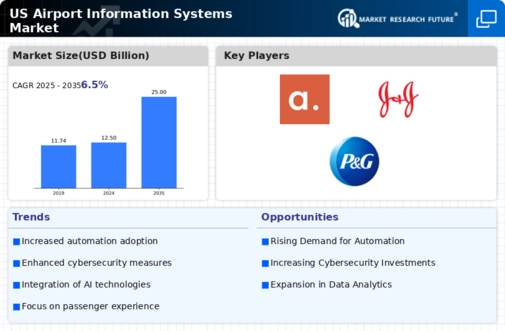Growing Demand for Real-Time Data
The airport information-systems market is experiencing a notable surge in demand for real-time data analytics. Airports are increasingly seeking systems that can provide instant insights into passenger flow, baggage handling, and flight status. This demand is driven by the need to enhance operational efficiency and improve passenger experience. According to recent data, the is projected to grow at a CAGR of approximately 15% over the next five years. This growth indicates a shift towards more data-driven decision-making processes within airport operations, which is essential for maintaining competitiveness in the aviation sector.
Regulatory Compliance and Standards
Regulatory compliance plays a crucial role in shaping the airport information-systems market. Airports must adhere to various federal regulations and standards, particularly concerning safety and security protocols. The Federal Aviation Administration (FAA) and Transportation Security Administration (TSA) impose stringent requirements that necessitate the implementation of advanced information systems. As a result, airports are investing in technologies that ensure compliance while optimizing operations. The financial implications of non-compliance can be severe, potentially leading to fines and operational disruptions, thus driving the need for robust information systems that align with regulatory frameworks.
Emergence of Smart Airport Initiatives
The emergence of smart airport initiatives is reshaping the landscape of the airport information-systems market. Airports are increasingly adopting smart technologies that leverage the Internet of Things (IoT), artificial intelligence (AI), and big data analytics to create more efficient and responsive environments. These initiatives aim to optimize resource allocation, enhance security measures, and improve passenger services. As airports strive to become smarter, the demand for sophisticated information systems that can integrate various technologies is likely to rise. This trend suggests a transformative shift in how airports operate, potentially leading to a more streamlined and effective travel experience.
Increased Focus on Passenger Experience
Enhancing passenger experience is a primary driver in the airport information-systems market. Airports are recognizing that a seamless travel experience can significantly influence customer satisfaction and loyalty. This focus has led to the adoption of innovative technologies such as mobile applications, self-service kiosks, and integrated information systems that provide real-time updates. Data suggests that airports investing in passenger-centric technologies can see an increase in customer satisfaction scores by up to 20%. Consequently, the airport information-systems market is evolving to meet these expectations, fostering a more engaging and efficient travel environment.
Investment in Infrastructure Modernization
Infrastructure modernization is a pivotal factor influencing the airport information-systems market. Many airports across the United States are undergoing significant upgrades to their facilities and technology. This modernization includes the integration of advanced information systems that enhance operational capabilities and improve overall efficiency. The Federal Aviation Administration has allocated substantial funding for airport improvement projects, with billions of dollars earmarked for modernization efforts. This investment not only supports the development of state-of-the-art information systems but also addresses the growing demands of air travel, ensuring that airports can accommodate future passenger volumes.














Leave a Comment